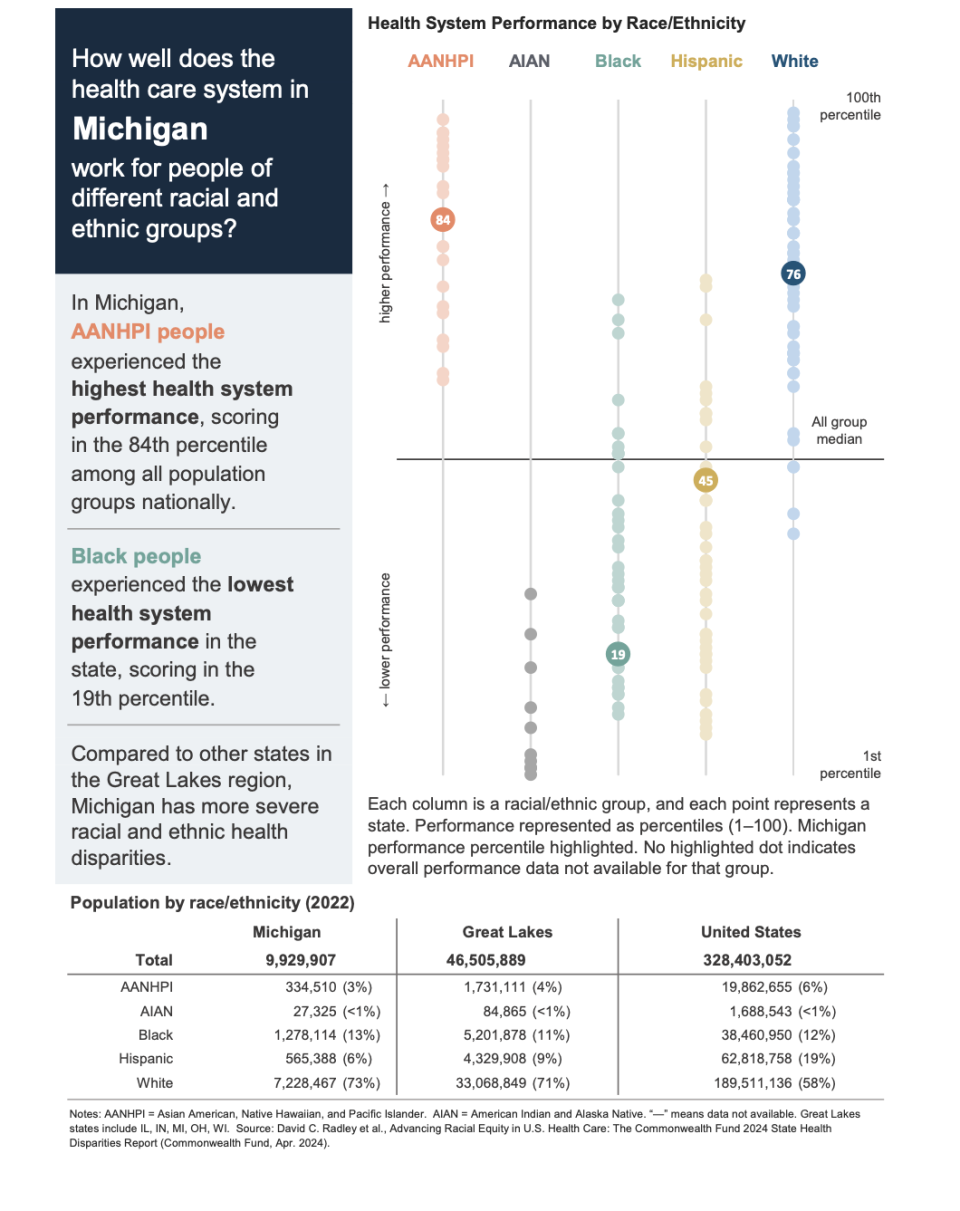Michigan’s health care disparities stark for Black residents
Michigan has more severe racial disparities in its health care system than other Great Lakes states, with Black residents experiencing the poorest outcomes, a new national analysis shows.
In a scorecard released Thursday by the Commonwealth Fund, Michigan placed 29th among 39 states examined in overall health care delivered to Black residents. Michigan also had “worse than average” health system performance for white residents compared with other states.
In most states, white residents received the best health care. But in Michigan, Asian Americans/Native Hawaiians/Pacific Islanders experienced the highest health system performance, scoring in the 84th percentile among population groups nationally. Health care for the state’s white residents ranked in the 76th percentile.
The report by the nonprofit research firm assessed data based on 25 indicators of health care performance, including health outcomes, access to health care and quality and use of health care services.

While health outcomes and health equity scores for Michigan’s Black residents were among the worst in the country, researchers and state health officials pointed out that disparities across racial and ethnic groups are prevalent nationwide, even among states that performed among the best in the assessment.
“This is not a Michigan issue. This is a problem that is across the United States. Michigan, in many of these areas, is doing better than a lot of our neighbors and a lot of other states,” said Dr. Natasha Bagdasarian, chief medical executive for the state.

Ohio, Iowa and Minnesota have slightly better health care for Black residents but still had assessments that were below the nation’s average. Illinois, Indiana, Wisconsin and Missouri scored even worse in health care quality.
Many states performed poorly when it comes to the health of women, mothers and babies, with high and increasing rates of maternal and infant mortality and inequities in pregnancy-related outcomes for Black and American Indian/Alaska Native women. Mortality increased during the pandemic.
'We are failing Black women'
“The areas in which we as a country are failing are on maternal and infant health," said Bagdasarian. “So our maternal mortality is the highest compared to other high-income countries.
“If we look at Black women in the United States, we are many-fold worse than our closest comparators. We are failing Black women when it comes to maternal mortality. We are failing Black infants when it comes to infant mortality. And again, this is across the board.”
Outcomes for Black mothers and babies are indeed grim. The Black infant mortality rate in Michigan was found higher than the national rate, with 13 infant deaths per 1,000 live births. The death rate is more than twice that of Latino, Asian and white babies, the report showed.
Besides infant mortality, the report evaluated adult obesity, cancer rates and screenings, out-of-pocket medical spending, preventable hospitalizations, emergency room visits and the cost of health care.
Where a person lives matters, noted the researchers, who called their report a roadmap for targeted federal and state policy solutions. Poverty, food insecurity, exposure to pollution and crime are prevalent in many communities where people of color live and green spaces are few, they said.
Black Michiganders face premature death from preventable causes
“This report demonstrates that if you don’t look under the hood, you won’t identify where you’re failing people and where you're leaving people behind,” said Dr. Joseph Betancourt, president of the Commonwealth Fund, which has tracked health and health care in every state for nearly two decades.
Safe housing, education and employment opportunities can also impact health equity. These factors can have a greater influence than genetics or access to health care services.
Achieving equity requires bold policy action, researchers said. Numerous studies have shown that many patients of color contend with discrimination in health care settings and more often receive worse medical care than white patients, according to the report.
“Health care systems can have the opportunity to have strong reporting systems and reconciliation systems that center equity and providing accountability to ensure that there’s an easy way, for example, to anonymously or even transparently report situations involving racism or discrimination,” said Dr. Laurie Zephyrin, the Commonwealth Fund’s senior vice president for advancing health equity.
Racial disparities in health care for Black and Native Americans are longstanding, with life expectancy shorter, on average. COVID-19 made things worse.
In Michigan, the data show that Black people are most likely to die prematurely from preventable causes, with 440 deaths for every 100,000 people. American Indians/Alaska Natives are also more likely to die early from preventable causes, with 314 deaths for every 100,000 people in Michigan.
Although Black people in the study had higher rates of deaths from preventable causes and infant mortality, most were insured.
Can policy changes close the gap?
This data raises questions on how residents perceive, access and interact with the health care system, said Phillip Levy, a physician and professor of emergency medicine at Wayne State University.
“Just because you have health insurance doesn’t mean you have the transportation to get to an office,” Levy said.
Since the Affordable Care Act became law in 2010, access to health care has improved, yet remains unattainable for many. Latino adults were found more likely in every state to skip health care because of costs, with higher rates of medical debt.
“When we looked at data that 25 million people in the United States are still uninsured, and they’re disproportionately people of color. And even for people who are insured about a quarter of working-age adults are underinsured. They’re really facing high out-of-pocket costs and deductibles, relative to their income, which really makes them not come in for care at all because they can’t afford it,” Zephyrin said.
Improving access and making health insurance more affordable is only part of the solution, she said.
Commonwealth Fund researchers also urged broad policy goals that would strengthen primary care; lower the administrative barriers for patients and providers and increase investments in social services such as housing and education.
Michigan has recently taken steps to address disparities, Bagdasarian said, by expanding Medicaid coverage for mothers and babies. The state also has established regional coalitions of community members and health and social care professionals that will address housing, transportation and nutritional needs.
Massachusetts, Rhode Island, Connecticut, Hawaii, New Hampshire and New York had better-than-average health care performance for all groups. Oklahoma, Arkansas, West Virginia and Mississippi had health care scores below average among all groups.
The analysis was conducted using publicly available databases reporting outcomes from more than 328 million people during 2021 and 2022.
This article originally appeared on Detroit Free Press: Michigan’s health care disparities stark for Black residents

